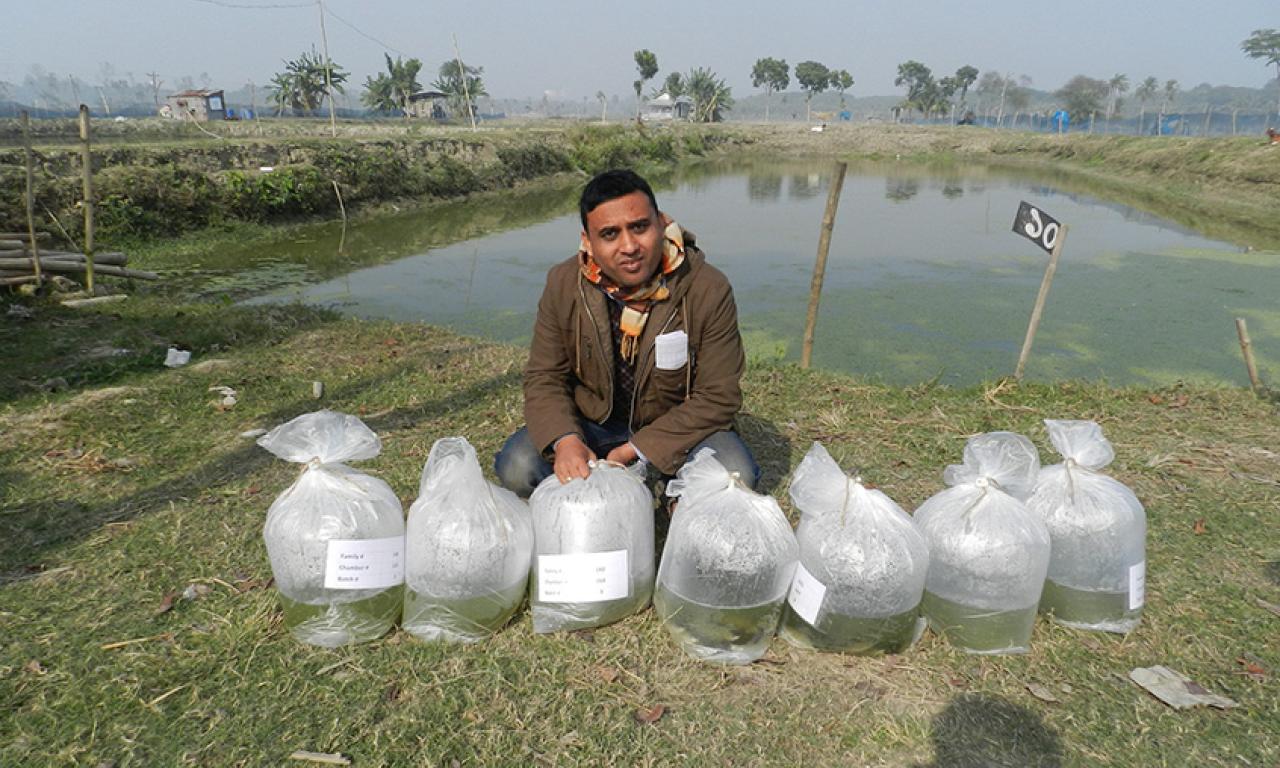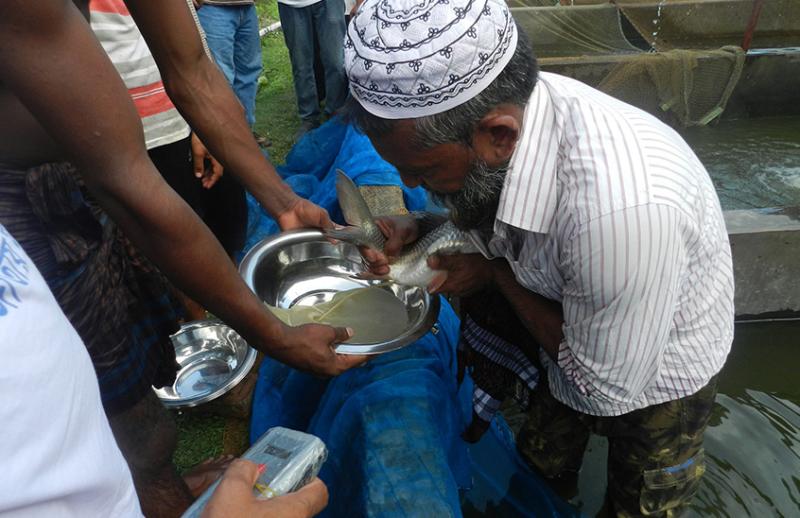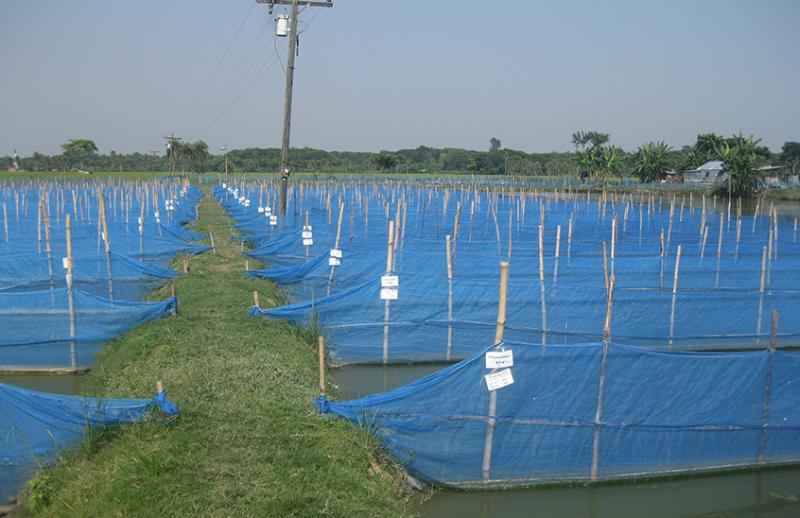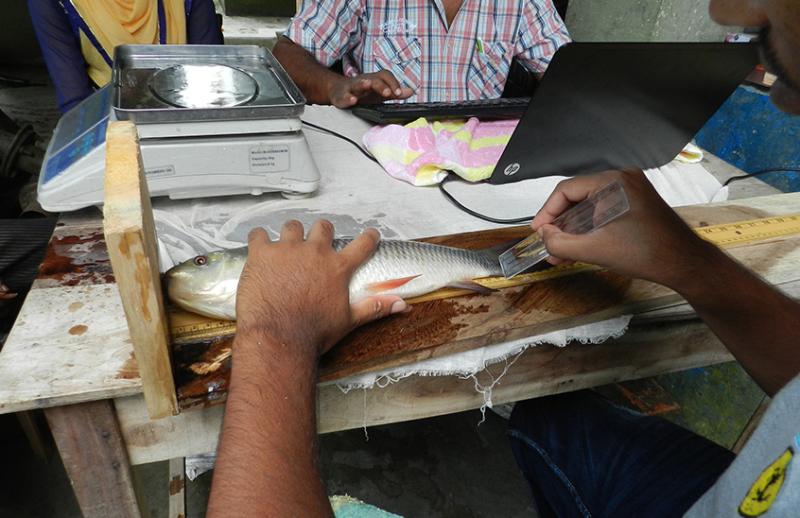
Since 2013, WorldFish has been running genetic improvement programs for Rohu, Catla and Silver carps in Bangladesh as part of a long-term plan to improve farmer access to quality seed of improved carp breeds, and thereby increase productivity.
Recommended publications
- Genetic improvement of carp reduces poverty, hunger in Asia
- Investing in carp seed quality improvements in homestead aquaculture: lessons from Bangladesh
Since 2013, WorldFish has been running genetic improvement programs for Rohu, Catla and Silver carps in Bangladesh as part of a long-term plan to improve farmer access to quality seed of improved carp breeds, and thereby increase productivity.
In Bangladesh, fish account for 60 percent of animal protein in a typical diet. Carp species are the most important fish species in Bangladesh, where more than 80 percent of aquaculture production is from inland ponds. The most farmed carp species are Rohu, Catla and Silver carp, which account for 25, 21 and 19 percent of the total production of fish from ponds, respectively. These fish are commonly grown together (known as polyculture) and these multispecies systems are highly productive.
However, commercial hatcheries in Bangladesh rely on wild brood stock to produce the fry for commercial farms, which often results in low productivity. These hatcheries use their own brood stock for a few generations until problems—low viability, deformities and poor growth, which are associated with high inbreeding levels—start to appear. When quality starts to dip the hatcheries go back to the rivers to collect new brood stock.

Genetic improvement programs for the major carp species, and subsequent farmer access to quality seed of the improved species, could have a big impact on the aquaculture production sector in Bangladesh.
To this end, in 2013, WorldFish developed a schedule of genetic improvement programs for these species and began the process with support from the USAID-funded Aquaculture for Income and Nutrition (AIN) project and from the CGIAR Livestock and Fish Research Program.
Spawn of Rohu and Catla was collected from three different rivers in Bangladesh with a view to using these as sources of new “good quality seeds” by the AIN project. A subsample of 300 fish from each of these three sources for each of the two species was set aside in 2013 to be the founders of the base populations of the breeding programs planned by WorldFish outlined in the table below.
| Year | ||||||||
| Species | 2014 | 2015 | 2016 | 2017 | 2018 | 2019 | 2020 | 2021 |
| Rohu | Base | 1st Generation |
2nd Generation | 3rd Generation | ||||
| Catla | Base | 1st Generation |
||||||
| Silver carp | Base | 1st Generation | 2nd Generation | |||||
The plan was to start in 2014 with Rohu, which has a life cycle of two years, when the fish collected from the wild as young had become mature. The breeding program of Catla, whose generation interval is three years, was to start one year later when those fish were mature. Silver carp, whose generation time is two years, will be started in 2017.
Rohu
In July 2014, around 450 fish were used to produce 210 families to create the base population for the breeding program. A detailed design (called a complete diallele cross) of mating fish from within and between the three sites was used so that any differences in performance of fish from the different sites could be assessed. These data would provide important information for the detailed design of the breeding program in subsequent years. The experiment itself was logistically demanding involving more than 210 fine meshed nylon net cages or ‘hapas’, the construction of 210 fenced “chambers” in ponds and feeding and measuring the growth in all these 420 separate enclosures for five months.

We grew the fry in hapas to compare their performance to fry raised in ponds, the traditional nursery system. A sample of fin tissue (known as a finclip) was taken from each of the parents used to produce the young for later DNA analysis.
In late December 2014 and early January 2015, rearing in the hapas and chambers was concluded and the older fish (now called fingerlings) were large enough to tag individually. Fingerlings from each family were tagged using passive integrated transponder (PIT) tags, which can be detected electronically and used to track individual fish. The fingerlings were stocked together in ponds for grow-out. During the grow-out period two different production systems were tested: the polyculture system which is the common production system of carps in Bangladesh and the monoculture system where the genetic improvement programs usually take place. So representatives of each of 72 of the Rohu families were put in a pond with Catla and Mrigal (another type of carp), and other representatives of the same families in a pond with no other species. Care was taken to match the overall densities of fish in the two ponds.

During October and November 2015, we harvested the fish and took measurements of body weight, standard length, width and depth at harvest. In 2016 the data were analyzed using best linear unbiased prediction (BLUP) to get the estimated breeding values (EBV) of the fish for growth. From the 210 families we have identified 160 families for high EBV for growth which we decided to keep for the breeding program (between families selection). The best candidates for growth from each family were used in single pair matings to produce the first generation of the improved strain (within family selection). A control line from fish with average EBV for growth was created for future comparison with the selection line and estimation of the response to selection.
In 2016 we also obtained the results of DNA sequencing of around 9,000 genetic markers (SNPs) of the parents. Given that the parents had been collected as very young fry from the wild, we did not know their genetic relationships. It was possible that a number had come from the same family. Mating closely-related fish can result in high levels of inbreeding and subsequent poor performance, and has to be avoided in breeding programs. In July 2016, the chosen fish were spawned successfully. The fingerlings will be ready for PIT tagging by late December 2016 or early January for 2017.
Catla
In 2016, we attempted to spawn the Catla as planned but were able to produce only 25 families because of poor condition of the broodstock at spawning. The decision was made to postpone further spawning until 2017 after moving the fish to another farm where improved conditions could be provided. The 880 fish from which the parents were to be chosen were finclipped and screened for 3,000 SNPs which will be used to assess their genetic relationships and so avoid mating between highly related individuals.
Silver carp
In early 2016, we collected random samples from Silver carp, Bighead carp and their crosses from different hatcheries in Bangladesh and took finclips. DNA sequencing of these samples was undertaken to get a set of genetic markers to use for identification of the pure Silver carp. Approximately 600 Silver carp collected throughout Bangladesh during 2016 have been sent for DNA sequencing using these genetic markers to test for their purity and decide which fish to include in the breeding planned for 2017.
The breeding programs of these three species will form a base for a developing a technology platform for aquaculture in Bangladesh. In addition, the breeding programs will provide the fish for WorldFish’s different research experiments on feeds, diseases and other disciplines. To date the program has now developed the first generation of Rohu selected for improved growth, established the base population for Catla and has set up the appropriate screening to identify the Silver carp to be included in a base population in 2017.